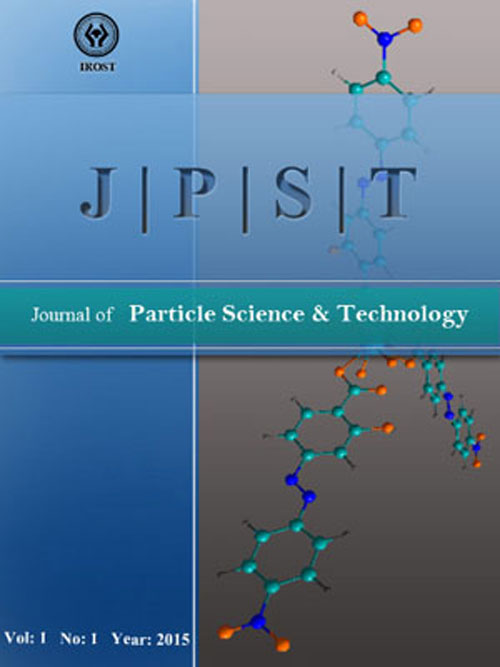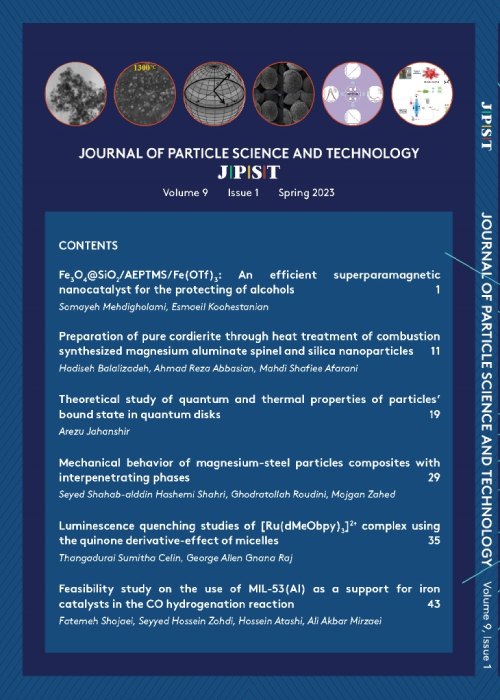فهرست مطالب

Journal of Particle Science and Technology
Volume:3 Issue: 2, Spring 2017
- تاریخ انتشار: 1396/03/30
- تعداد عناوین: 6
-
-
Pages 63-69The pool boiling heat transfer coefficient of pure liquids were experimentally measured on a horizontal bar heater at atmospheric pressure. These measurements were conducted for more than three hundred data in thermal currents up to 350 kW.m-2. Original correlations and the unique effect of these correlations on experimental data were discussed briefly. According to the analysis, a new empirical relationship implying a performance superior to other available correlations is presented.
Highlights
Dimensionless groups were created linking new boiling heat transfer coefficient to physical properties of boiling liquids.
Boiling heat transfer coefficient of liquids increased slowly through an increase in heat flux.
A precise correlation was achieved to link dimensionless groups by optimizing the model using genetic algorithm.Keywords: pool boiling, Heat transfer, atmosphere pressure, heat transfer coefficient -
Pages 71-77Silk fabrics were modified by a treatment of silver nitrate solution (AgNO3) and polyvinylpyrrolidone (PVP) as a stabilizer then exposure to γ-irradiation to create antibacterial properties. Effects of the absorbed dose on treated fabrics were investigated. The scanning electron microscopy (SEM) and X-ray diffraction (XRD) patterns were used to confirm the presence of silver nanoparticles (AgNPs) on the fabric. The treated fabrics should have enhanced thermal stability due to the presence of AgNPs. The treated silk fabric was examined for its antibacterial activity toward various types of bacteria. The AgNPs-treated silk fabrics demonstrated excellent antibacterial activity against the tested bacteria, Escherichia coli and Staphylococcus aureus. This work opens the door for production of specific AgNPs-silk as a type of textile in the antibacterial domain.
Highlights
Fabrics were carried out by coating with silver nanoparticles (AgNPs) stabilized with polyvinylpyrrolidone (PVP) through γ-irradiation.
The AgNPs-coated silk fabrics demonstrated an excellent antibacterial activity against the tested bacteria, Escherichia coli and Staphylococcus aureus.
This work offers potentials to produce specific AgNPs-coated antimicrobial silk for various applications in the textile industry.Keywords: Silk, silver nanoparticle, Antibacterial activity, Surface modification, ?, Irradiation -
Pages 79-87Adsorption of malachite green (MG) from an aqueous solution onto unexpanded perlite (UP), expanded perlite (EP) and NaOH-modified unexpanded perlite (NaOH-UP) powders has been investigated. The effects of contact time, pH, initial dye concentration, adsorbent dosage and temperature have been evaluated. The adsorbents were characterized by Brunauer-Emmett-Teller (BET) analysis, Fourier transform infrared (FTIR) spectroscopy, and scanning electron microscopy (SEM). The obtained results proved that the three examined powders can be used successfully for removal of MG from aqueous solutions as low cost mineral adsorbents. The maximum adsorption capacities of UP, EP and NaOH-UP were 23.81 mg/g, 29.41 mg/g and 39.68 mg/g, respectively. Kinetic studies show that the kinetics of the MG adsorption onto the adsorbents followed the second order model. The MG equilibrium adsorption data were best described by the Langmuir isotherm model for all adsorbents.
Highlights
An easily available low-cost mineral (Perlite) is modified for adsorption.
Chemically modified perlite was used to remove malachite green from an aqueous solution for the first time.
Modified adsorbents were characterized by FTIR and SEM analyses.
Adsorption kinetics, isotherm and effects of the influential parameters were studied.Keywords: Modified perlite, Isotherm, Malachite green, Adsorption -
Pages 89-99In the present work, the drying of calcium carbonate in a batch spouted bed dryer with inert particles has been investigated experimentally. The effect of several operating parameters including air temperature (90, 100, and 110 ˚C), air velocity (Ums, 1.2 Ums, and 1.5 Ums), and dry solid mass (5, 10, 20 g) has been studied. The Taguchi method has been applied to determine the optimal parameters and also to reduce the number of required experimental runs. It has been found that the dryer performance was affected by all parameters. It has also been found that drying with 5 g dry solid at a temperature of 100 ˚C and a velocity of 1.2 Ums leads to maximum drying efficiency. Additionally, the effect of air inlet velocity and temperature on the drying kinetics of calcium carbonate has been investigated. Several semi-theoretical models with temperature and velocity dependent parameters have been selected to estimate the drying kinetics. The performance of all fitted models was acceptable but the logarithmic model was the best model in terms of the statistical analysis.
Highlights
A new batch spouted bed dryer was investigated for drying calcium carbonate.
A new criterion has been introduced to measure the effective efficiency of the drying process.
The drying kinetics have been modelled using semi-theoretical approaches.Keywords: Spouted bed dryer, Drying kinetics, Taguchi method, Drying effective efficiency, Modeling -
Pages 101-112In this work, thorium (IV) removal from aqueous solutions was investigated in batch systems of cationic and anionic resins of Amberlite IR-120 and IRA-400. In this way, the effects of pH, initial Th(IV) concentration and the amount of adsorbent were investigated. A Central Composite Design (CCD) under Response Surface Methodology (RSM) was employed to determine the optimized condition. The results showed that the maximum removal efficiency of Th(IV) onto IR-120 and IRA-400 either discretely or in combination, albeit with equal mass fraction, was determined as follows: 98.09% , 65.70% and 72.19% at pH=3.23, 6 and 4.07, initial Th(IV) concentration of 78.2, 30 and 55.4 mg.L-1 and 2.08, 2.5 and 2.2 g.L-1 of resin, respectively. The kinetic and equilibrium data were accurately described by the pseudo-second order and Langmuir models. The results showed that IR-120 is a suitable adsorbent for thorium removal from aqueous solutions.
Highlights
A novel PVA/TiO2/ZnO/TMPTMS nanofiber adsorbent was fabricated by the electrospinning method.
The effects of pH, initial Th(IV) concentration and the amount of adsorbent were investigated.
The properties of the prepared novel adsorbent were determined by SEM, FTIR and BET analyses.
The adsorption capacity of Th(IV) in a single system was reported.
The mechanism of Th(IV) adsorption was recognized.Keywords: Th(IV) Removal, Response surface methodology, Central Composite Design, Ion Exchange Resin -
Pages 113-120In the present study, the effect of various nanofluids on mass transfer coefficients in an irregular packed liquid-liquid extraction column was investigated. The chemical system of tolueneacetic acidwater was used. 10 nm SiO2, TiO2 and ZrO2 nanoparticles with various concentrations were dispersed in toluene-acid acetic to provide nanofluids. The influence of concentration and hydrophobicity/hydrophilicity of nanoparticle on mass transfer coefficient was discussed. The experimental results show that the mass transfer coefficient enhancement depends on the kind and the concentration of nanoparticles. The maximum enhancement of 35%, 245% and 207% was achieved for 0.05 vol% of SiO2, TiO2 and ZrO2 nanofluids, respectively. A new conceptual model was proposed for prediction of the effective diffusivity as a function of nanoparticle concentration, drop size and drop Reynolds number.
Highlights
In this study, the effect of various nanoparticles on the mass transfer coefficient was investigated.
Maximum enhancements in mass transfer coefficient of 35%, 245% and 207% were achieved in the presence of SiO2, TiO2 and ZrO2, respectively.
A new conceptual model was proposed for prediction of the effective diffusivity as a function of nanoparticle concentration, drop size and drop Reynolds number with a high accuracy.Keywords: Liquid, liquid extraction, nanoparticles, Mass transfer coefficient, Hydrophobic, Hydrophilic


